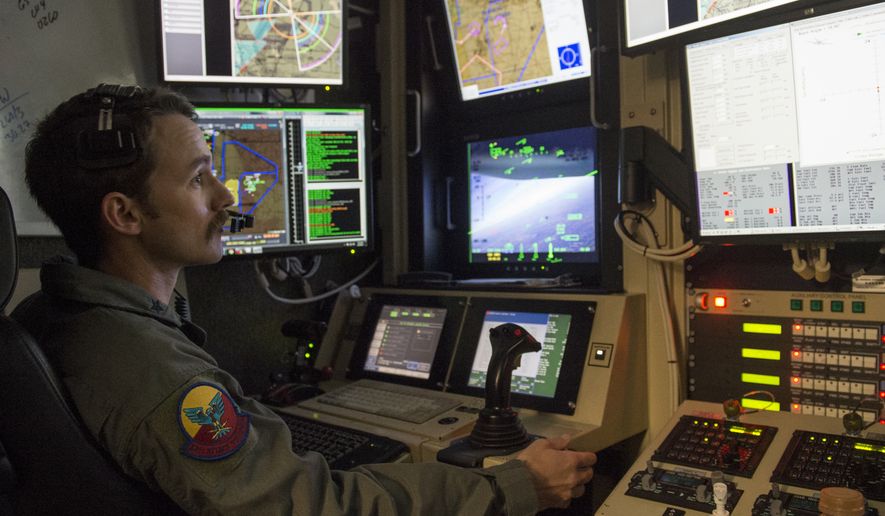The pilots and sensor operators who fly America’s military drones have taken on a lion’s share of the Air Force aerial combat missions for more than 20 years.
Since the attacks of September 2001, the demands for remotely piloted aircraft (RPAs) and their two-member crews have grown dramatically. The ability of the craft to linger for an extended period over hostile territory means they can provide critical intelligence and surveillance around the clock and direct bombs to the proper targets if needed.
But the overwhelming demands for RPA missions in recent years has resulted in a critical shortage of pilots, who are officers, and the enlisted sensor operators, according to an analysis by the Government Accountability Office. The Air Force, the congressional watchdog warned, had not done enough to keep the personnel supply lines full.
“The trend has not been enough to meet the increased number of [congressionally] authorized positions in this RPA career field,” the report found. “For a majority of the time in fiscal years 2016 through 2019, the Air Force’s number of assigned RPA pilots and sensor operators was less than both of their respective authorizations and requirements.”
One result, the GAO said, was that operators were being forced to perform longer shifts and carry out consecutive missions without taking rest. Many overburdened operators have left the Air Force for the Air National Guard or for more-lucrative, less-stressful work in the private sector.
“People join the Air Force to see and do things, not to be exposed to constant combat operations in less than appealing circumstances,” the GAO said.
The Air Force’s MQ-9 Reaper first drew blood in October 2007 when one launched a Hellfire missile at a group of Afghan insurgents attacking U.S. troops. It was another Reaper crew this January that fired several missiles at a two-car convoy leaving Baghdad International Airport, killing top Iranian commander Maj. Gen. Qassem Soleimani and Abu Mahdi al-Muhandis, commander of an Iranian-backed Shiite militia group.
Constant combat operations have created challenges for Air Force pilots and sensor operators who conduct missions around the world. Since at least 2016, the Air Force has had fewer RPA pilots and sensor operators than authorized, the GAO said in its report, “Unmanned Aerial Systems: Air Force Should Take Additional Steps to Improve Aircrew Staffing and Support.”
Searching for reasons
No one doubts that the Air Force’s RPA community has a critical crew shortage, said Paul Scharre, a senior fellow at the Center for a New American Security in Washington. The only question is why.
“The Air Force has had ample time to grow pilot and sensor operators to make this community healthy. They’ve chosen not to,” said Mr. Scharre, author of a book on how drones are changing the nature of modern warfare.
The Air Force, he said, doesn’t value the RPA mission, which is focused on counterterrorism efforts rather than the traditional mission of dominating the skies.
“In the minds of Air Force leadership, it’s not a top priority,” Mr. Scharre said. “This problem has been going on for a decade.”
The Air Force declined to comment directly on the RPA crew shortages and referred a reporter for its official response to the GAO audit to Air Force Lt. Gen. Brian T. Kelly, the deputy chief of staff for manpower, personnel and services.
The Air Force has provided financial incentives to address retention of RPA personnel but says it doesn’t have sufficient historical data to help predict how many operators will stay on and how many will need to be replaced, according to the report. The Air Force has not “consistently” met its accession targets for RPA pilots and sensor operators from fiscal year 2016 through 2019, GAO investigators said.
The Air Force also is having difficulty keeping its core of pilots and sensor operators, who are increasingly being lured away by better-paying civilian employers.
“There are not enough [pilots] to meet the requirements,” Mr. Scharre said. The contractor community, he added, is “poaching [the military’s] pilot and sensor operators.”
Since 2016, the Air Force also has experienced critical instructor staffing shortages. At one point, Air Force officials temporarily reduced the length of training to try to ease the instructor gap. In response to the GAO report, the Air Force said it had requested an updated study of the “appropriate” pilot and sensor operator instructor manning levels.
“While delayed by COVID-19 response measures, estimated completion and final results (of the study) are expected in 12 months,” the Air Force said.
The GAO report also recommended tracking the progress of the Air Force’s effort to obtain sufficient quantities of RPA pilots and sensor operators in order for units to be able to have sufficient “dwell time” — the time they spend in noncombat operations such as training.
Pentagon officials say that as the career field “matures,” they will get a better handle on staffing needs and retention levels, even as drone warfare needs are expected to only accelerate.
While the U.S. is shifting from the global war on terror toward confronting “great power” competitors such as China and Russia, there is no future in modern combat without remotely piloted aircraft, Mr. Scharre said.
“Just because we’re seeing Russian being more aggressive in Europe and China investing in military modernization, that doesn’t mean the terrorism threat goes away,” he said. “The Department of Defense can walk and chew gum at the same time.
“It’s not an ’either/or’ choice,” he added.
• Mike Glenn can be reached at mglenn@washingtontimes.com.




Please read our comment policy before commenting.